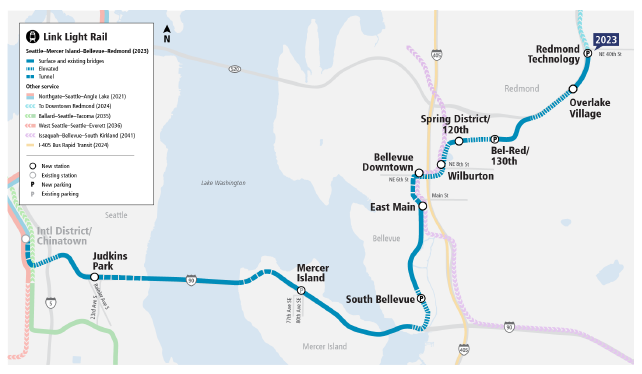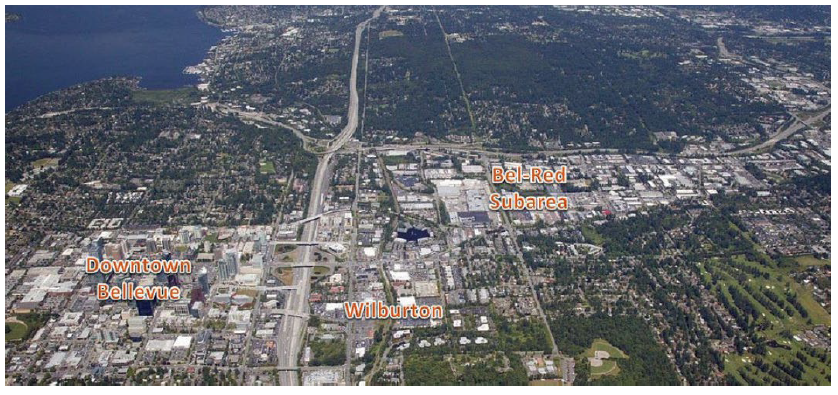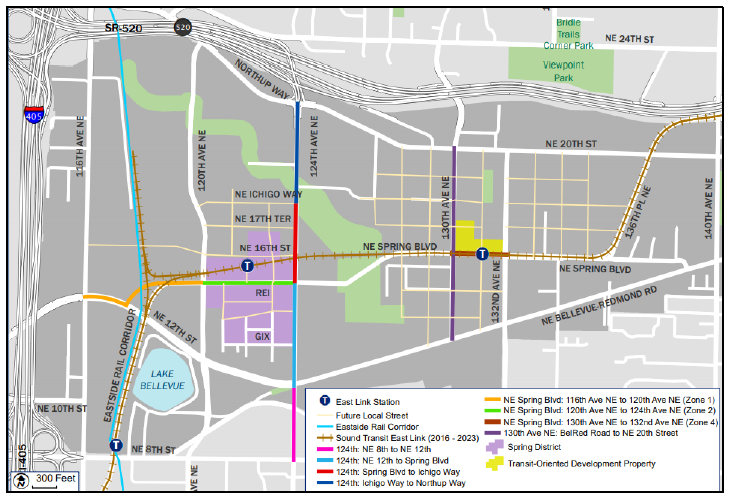The Bellevue-Redmond (Bel-Red) corridor project highlights how impact fees may be used to finance improvements and drive the development of a multimodal transportation district that includes arterial streets, bicycle paths, pedestrian paths, and significant roadway enhancements.
The corridor connecting Redmond, Bellevue, and Seattle in Washington State is one of the fastest-growing areas of the Pacific Northwest. With the Central Puget Sound Regional Transit Authority, known as Sound Transit, expanding its light rail network across metro Seattle, the city of Bellevue saw an opportunity to promote transit-oriented development around the future light rail line and generate maximum benefit from it.
Bellevue focused its planning efforts on the Bel-Red subarea, a 900-acre, strategically located neighborhood. Bel-Red links three key parts of the region: Downtown Bellevue, a dynamic, high-rise employment and residential center; Wilburton, a major, multiple-institution medical district; and Redmond's Overlake area, a prominent, high-technology employment center that is home to Microsoft's headquarters. The area is also conveniently located near the I-405 and SR-520 highways.
The original alignment for Sound Transit's East Link Project followed SR-520 before turning into downtown Bellevue. To maximize transit-oriented development, the city proposed an alternative alignment that would bring the line into a light industrial district several blocks inside the highway. Figure 1 shows the ultimate alignment of the light rail line.

The Bel-Red subarea had long been the location of light industrial uses, including warehouses and auto repair shops. Bellevue saw the opportunity to transform the 900-acre site into mixed-use, transit-oriented neighborhoods while improving the environment and creating thousands of new jobs and housing units. The vision, defined by the city of Bellevue's Citizen Steering Committee, comprised the following six goals:
The redevelopment was estimated to cost $200 million, of which a significant portion was expected to come from zoning incentives and citywide impact fees. Other sources of financing were expected to be from TIFIA loans and State grants. An aerial view of the light industrial area, pre-development, is shown in Figure 2. Upon completion, the area will be home to three of Bellevue's six light rail stations:

The location of the three stations, as well as a schematic of the overall land use plan for the Bel-Red subarea, is shown in Figure 2. The Bel-Red subarea is bound by SR-520 to the north, I-405 to the west, Bel-Red Road to the south, and 148th Avenue to the east.
To ensure that the East Link Project will support Bellevue's smart growth goals, each station is put through Sound Transit's station area planning process, in addition to an overall master plan.
The city's overall master plan comprises a variety of multimodal transportation investments designed to leverage the East Link Extension to the greatest extent possible, including arterial streets, bicycle facilities, pedestrian facilities, parks, and stream enhancements. Roadway improvements include new connections, realignments, widenings, turn pockets, new and upgraded signals, bike lanes, sidewalks, landscaping, drainage, and street lighting.

The city had to manage several regulatory issues in executing its plan for the project.
Rezoning of the Subarea
The most obvious need was for the city to rezone the subarea from light industrial to accommodate mixed-use commercial development. The rezoning was relatively uncontroversial among property owners, because there was no existing residential space in the area and the rezoning greatly increased property values.
Washington's Growth Management Act
The Washington State Growth Management Act is a State law that requires municipalities to manage growth by designating urban growth areas, preparing comprehensive plans and implementing them through capital investments and development regulations. This act provided guiding principles in the planning process.
Tax Increment Financing
In Washington, State property tax revenues cannot be diverted for local economic development as is the case with traditional tax increment financing (TIF). Traditional TIF was ruled unconstitutional by the Washington State Supreme Court because it diverts State property tax revenue from schools.
Washington's "budget-based" property tax system makes it impossible for a local government to capture property value increases that are driven by public investments. Property taxes are levied in gross amounts, based on budgetary needs and subject to a statutory cap. Because of statutory caps on budget amounts, increases in assessed values are not captured by municipalities under existing law.
The lack of TIF meant there were few ways for the city to capture the increased property values in the new zone.
The primary market consideration was real estate market risk. However, the strategic location of the Bel-Red Street Network project proved highly desirable to new businesses and developers well in advance of project completion. REI, the global sporting goods retailer, is constructing its global headquarters in the district. Also under construction is a 100,000-square-foot Global Innovation Exchange, a graduate academic institute focused on technology innovation created by a partnership between the University of Washington and Tsinghua University of Beijing and supported by Microsoft. In total, at least 3.3 million square feet of retail and residential space is under development in the subarea.
Investment Strategy
To develop the street network, the city budgeted $200 million out of an overall $500 million citywide budget for transportation improvements. The project's investment strategy will include city revenues supported by developer contributions from impact fees, right-of-way contributions, and zoning incentives, as well as transit agency revenue and Federal and State grants. A developer zoning incentive system will help fund open space and stream restoration and contribute to affordable housing, so that development will partially fund its own needs.
Transportation Infrastructure Finance and Innovation Act (TIFIA) Loan
To fund the street network improvements, the city applied for and was granted a $100 million TIFIA direct loan. The TIFIA loan is secured by a limited tax general obligation pledge from the city of Bellevue. The TIFIA loan agreement was executed on June 9, 2017, and is expected to mature in 2056. The loan has an interest rate of 2.86 percent and a term of 35 years after substantial completion to finance the completion of the street network improvements.
Development Impact Fees
Developers pay impact fees on new developments to help mitigate traffic impacts and to provide some of the funding for the city's transportation infrastructure. Both the Bellevue City Code and the State Growth Management Act discussed previously authorize these fees.
Bellevue's transportation impact fees vary for different types of land uses. Residential fees and commercial fees, for example, are not the same because of the differences in the amount of traffic generated by each type of development.
Incremental Revenue Analysis
To help justify its street network improvements, Bellevue calculated the expected incremental revenue that would be generated through densification and higher value development in the Bel-Red subarea. By showing evidence that the State stood to gain significant incremental revenue from the Bel-Red developments, Bellevue was able to build a strong case in its requests for State grant money to fund street network improvements.
| Stakeholder | City | County | State | Other Districts | Total |
|---|---|---|---|---|---|
| Property Taxes | $3,500 | $3,000 | $8,700 | $20,700 | $36,300 |
| Sales Tax on Construction | $3,300 | $4,500 | $25,200 | $3,500 | $36,500 |
| Ongoing Sales Tax | $12,500 | $16,900 | $95,300 | $13,200 | $137,900 |
| Business and Occupation Tax on Construction | N/A | N/A | $7,000 | N/A | $7,000 |
| Ongoing Business and Occupation Tax | N/A | N/A | $16,800 | N/A | $16,800 |
| Utility Taxes | $1,500 | N/A | $700 | N/A | $2,200 |
| Total Incremental Revenues | $20,800 | $24,400 | $153,700 | $37,400 | $236,700 |
City-Sound Transit
To undertake the project, the city needed to convince Sound Transit to relocate the original planned route parallel to State Route 520 south into the subarea. This would involve extra cost to Sound Transit since it would need to acquire land in the subarea, unlike along State Route 520. Ultimately, Sound Transit agreed on the basis that relocating the line would improve ridership numbers, which would in turn help Sound Transit's revenue and business case for the East Link Extension over the longer term.
City-Business
The city coordinated with businesses throughout the master planning process to ensure the transportation network would be fit for purpose. It is funding part of the infrastructure improvements through impact fees on development. The city needed to achieve buy-in from potential developers to set and levy the fees. Those fees are levied on a citywide basis and not unique to the subarea, however.
City-Community
The city set up a Community Steering Group to guide the planning and set overarching goals.